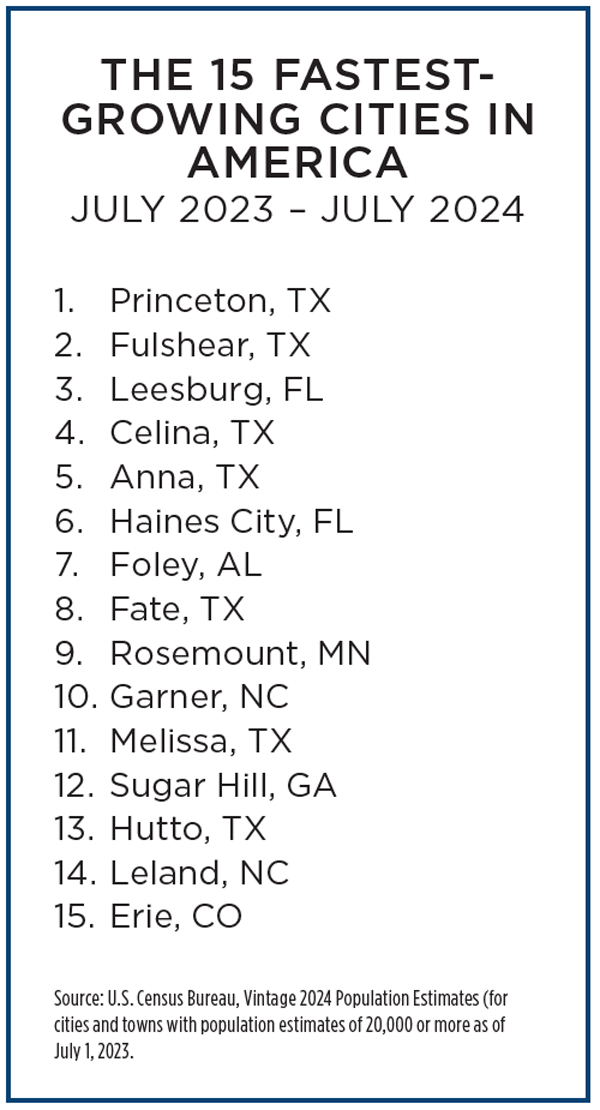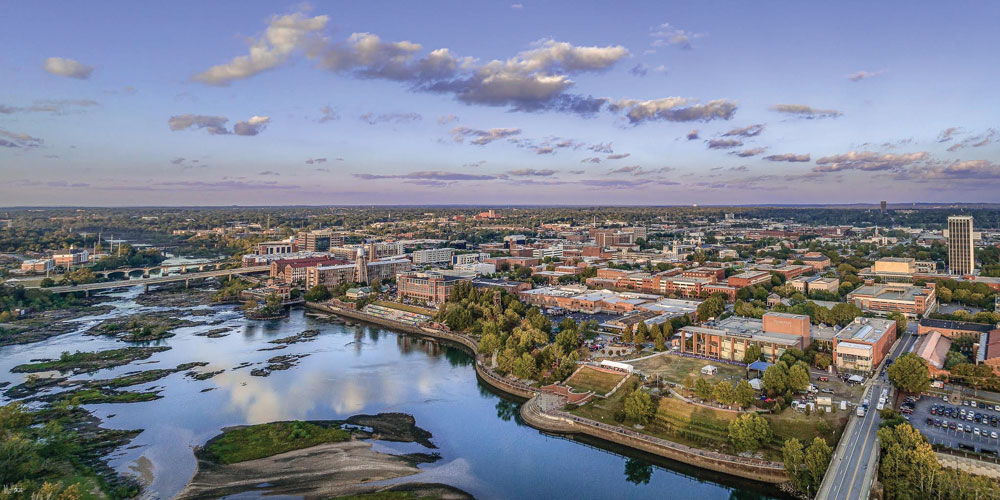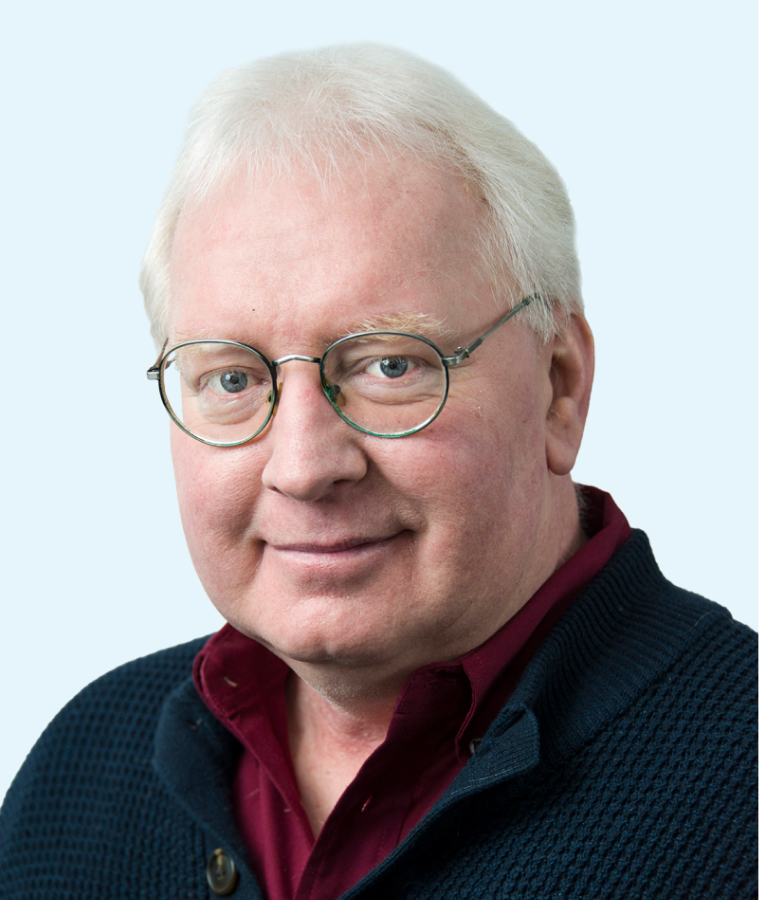Why talented workers are choosing places in the American heartland.
Want to know why so many Americans are choosing to relocate to small towns and rural communities? Talk to the folks who have made the move.
When Roshonda Hightower moved last year from Albany, Georgia, to Tell City, Indiana, she said she did so “for the peace and affordability that’s hard to find in the big cities.” She added, “As a remote worker, I wanted a place with a strong sense of community, beautiful surroundings and a slower pace of life. Tell City in Perry County, having the reliable fiber internet which I needed as a remote worker, checked all the boxes.”
Hightower is far from alone. All across the U.S., individuals and families are opting for a quieter and often safer lifestyle by ditching the bright lights of the big city and moving to Small Town USA. The numbers back it up.
According to a May 15 press release from the U.S. Census Bureau, the 15 fastest-growing cities and towns between July 1, 2023, and July 1, 2024, with populations of 20,000 or more were all smaller cities. Princeton, Texas, led the way with a whopping 30.6% increase in population in just one year, growing its total residents to 37,019. Fulshear, Texas, came in second with a 26.9% increase to 54,629, followed by Leesburg, Florida, which grew by 18.5% to 37,815. Of the 15 fastest-growing cities in America, seven are in Texas. (See chart, p. 82.)
In Hightower’s case, she left behind Albany, a city of 66,877, for Tell City, a place of 7,485 people. “There’s something about the slower pace, friendly faces and quiet beauty of this place that’s brought me a sense of peace I didn’t realize I was missing,” Hightower says. “Remote work gave me the freedom; Tell City gave me the calm. My move to Tell City wasn’t just a leap of faith – it was a smart one.”
Perry County is one of a growing number of places that participates with MakeMyMove.org to incentivize people who desire a slower pace of life in a small-town setting. So does Columbus, Georgia, which recently secured a new resident in Althea McBride, who left behind Los Angeles and its 3.88 million people for her new hometown – a mid-sized city of 201,877 people in southwestern Georgia.
“People expect Columbus to be slow, but it is Georgia’s second largest city,” McBride says. “It is more like Culver City, California. There are a lot of different things to do in Columbus; and it is only 90 minutes from Atlanta. Columbus has its own airport, allowing me to travel for my job as a remote worker.”
‘Welcome Home’ Is More Than a Slogan
Communities that participate in the MakeMyMove program typically offer cash incentives of anywhere from $5,000 to $15,000 to help newcomers cover the costs of moving expenses. Beyond that, they help the new residents meet people, join clubs and integrate into their new hometowns.
McBride says other benefits include free membership for a year at a local swimming pool and six months of free access to a coworking space in Columbus. “They have a lot of mixers so that you can meet other new residents in town,” she says. “I have been able to network with people through this program. It helped me get my feet planted.”
Getting your feet planted is a big deal for new residents. Evan Hock , chief operating officer at MakeMyMove, says that is where his organization excels. “We view the word ‘welcoming’ as an active verb,” he says. “We want to know what each community is going to do to help people make the move. We look at customer service and how quickly they are responding to messages through our platform.”

“There are a lot of different things to do in Columbus; it is only 90 minutes from Atlanta…. and has its own airport, allowing me to travel for my job as a remote worker.”
— Althea McBride, new resident of Columbus, Georgia
Hock ’s group even ranks these communities on how effective they are at rolling out the welcome mat to new residents. Selected for their innovative approaches to population growth and community integration, this year’s Most Welcoming Places, says Hock , are:
- Columbus, Georgia
- Eastern Kentucky
- Noblesville, Indiana
- Perry County, Indiana
- Texarkana, Arkansas-Texas
- Tulsa, Oklahoma
“The communities understand that relocation isn’t just about moving houses. It’s about building a life,” says Hock . “The leaders behind these programs are creating real human connections, removing barriers for newcomers and proving that a welcoming community is the best incentive of all.”
Columbus, for example, has implemented a program to strategically increase its population by 4% by 2026. It uses a matchmaking approach to identify and select movers who will relocate for the long term. In Perry County, Shiraz Mukarram, an immigrant turned local leader, takes welcoming new movers personally and provides 24/7 support to help each new resident settle in.

“My move to Tell City wasn’t just a leap of faith — it was a smart one.”
— Roshonda Hightower, new resident of Tell City in Perry County, Indiana
By all accounts, these programs are working, says Hock , resulting in thousands of new residents collectively relocating each year to these smaller towns and cities.
Moreover, these newcomers are often bringing high-wage jobs with them, whether as remote workers or as new hires at local companies. In that sense, they are fulfilling an economic development goal of their newly adopted communities.
What’s Driving People to Small Towns?
New York-based Development Counsellors International recently conducted a study of people who relocated and discovered that the most important factors driving the relocation decision were cost of living and financial security. The report, titled “Talent Wars,” looked at where people were moving across the U.S. and Canada.

Study co-author Patience Fairbrother of DCI said that, “Increasingly, people had a lot more flexibility post-COVID. People associate quality of life with financial security. Lowering your cost of living jumped up into the top three triggers for relocating.”
Co-author Robyn Domber said there are implications for employers from this exodus of people from large city centers.
“There is almost sort of a reverse industrial revolution happening,” she says. “Companies now have to look further out from the urban centers. Talent is now looking to do the reverse commute. They have to look even further out of the city centers for job opportunities. Talent will want to live closer to where they are working.”
Other factors driving the relocation decision, the authors said, include the cost of housing and a desire to be closer to family.
“People are defining quality of life around must-have factors like cost of living and safety,” says Fairbrother. “Culture and nightlife are now considered to be more the nice-to-have things, but they are not the driver anymore.”
As talented workers with skills continue to relocate to smaller and more outlying communities, they are dragging big-budget capital investments with them. An analysis of the Conway Projects Database shows that nine projects of $1 billion or greater landed in micropolitan areas around the U.S. over the past 12 months. These included the $10 billion data center campus investment of Compass Datacenters in Meridian, Mississippi, and the $1.35 billion Microporous LLC electronics investment in Danville, Virginia.
Other micropolitan areas to receive large-scale projects over the past year include Williston, North Dakota; Columbus, Mississippi; Jamestown, North Dakota; and Orangeburg, South Carolina. Another 11 deals of $250 million or more went to small towns around the country, per the official projects database of Site Selection.
Domber of DCI says she expects these relocation trends to continue. “We are seeing the impact of the Great Reflection that we saw during COVID,” she says. “People are reassessing what is most meaningful to them. People now are refocused on the stability factor and affordability.”
When asked how they would advise small towns or rural communities on how to attract talented workers, Fairbrother says:
- “First and foremost, lead with your affordability advantage and make that front and center in your marketing materials.”
- “Secondly, address safety concerns up front. Be up front with the data and make it readily accessible.”
- “Thirdly, make your own residents available as marketers. The people currently living in your community are your best advocates.”

